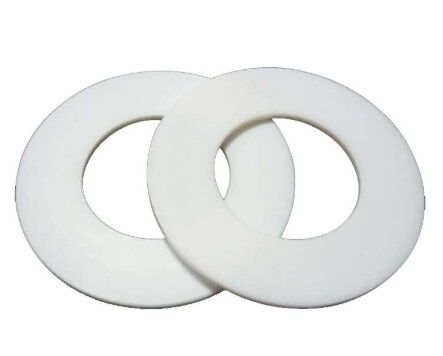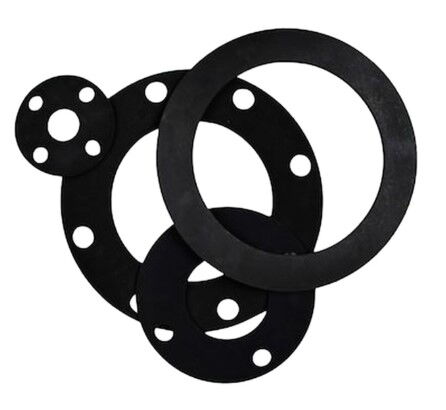In industrial production, sealing technology is a crucial element in ensuring the safe operation of equipment and the efficiency of production. Gaskets, as an essential part of the sealing system, play a vital role in the success or failure of the sealing effect. This article will focus on two common types of gasket materials, PTFE gaskets and rubber gaskets. We will provide a detailed analysis of their performance characteristics, application scenarios, and usage precautions to help readers better understand and select the appropriate gasket material.
In the field of industrial sealing, PTFE gaskets stand out for their exceptional corrosion resistance, making them the first choice for many engineers and technicians. Their stable performance in harsh environments such as strong acids and alkalis makes them a reliable partner for handling complex chemical media. Let's delve into the performance characteristics and application scenarios of PTFE gaskets to explore why they excel among various sealing materials.

PTFE gaskets are primarily made from polytetrafluoroethylene (PTFE). PTFE is a material with outstanding corrosion resistance, capable of maintaining stability in highly corrosive media such as strong acids, alkalis, and halogens. It is almost insoluble in any solvent at room temperature, making it excellent for handling chemical substances. However, PTFE is prone to cold flow and creep under pressure and high-temperature conditions. This means that the material's shape can gradually change, leading to a decrease in sealing pressure. Therefore, PTFE gaskets are typically suitable for low-pressure, moderate-temperature environments, with a safe operating temperature generally below 150°C and a pressure not exceeding 1 MPa.
Cold Flow and Creep: PTFE exhibits creep under high temperature and pressure, leading to a gradual decrease in the compressive stress on the sealing surface over time. This phenomenon, known as "stress relaxation," is particularly noticeable in PTFE gaskets. To mitigate this effect, PTFE is often filled with other materials to enhance its strength. However, the operating temperature of the filled material should not exceed 200°C, and its corrosion resistance may be slightly reduced.
Coefficient of Friction: PTFE has a low coefficient of friction, which is between 0.035 and 0.04 when the compressive stress exceeds 4 MPa. This makes PTFE gaskets prone to slipping outward during pre-tightening. To address this issue, it is common to use raised-face flanges to increase friction and prevent gasket slippage. If flat flanges are used, the outer diameter of the gasket can be made to contact the bolts to prevent outward slipping.
Corrosion Resistance: PTFE gaskets have extremely strong corrosion resistance, capable of withstanding almost all strong acids, strong oxidizing agents, reducing agents, and organic solvents, except for molten alkali metals, fluorinated media, and sodium hydroxide above 300°C. This makes them widely used in industries such as petrochemicals, pharmaceuticals, and food processing.
PTFE gaskets are widely used in applications that require corrosion resistance and prevention of contamination. For example, in the pharmaceutical industry, where the production of medicines demands high levels of hygiene and purity, PTFE gaskets can effectively prevent contamination of the drugs. In the petrochemical sector, PTFE gaskets are used to handle corrosive media such as strong acids and alkalis, ensuring the safe operation of equipment. Additionally, PTFE gaskets are suitable for equipment like diaphragm pumps and metering pumps, which need to maintain sealing performance in complex chemical environments.
Temperature and Pressure Control: The operating temperature of PTFE gaskets should not exceed 150°C, and the pressure should not exceed 1 MPa. If higher temperatures or pressures are required, other types of gaskets should be considered.
Flange Design: To prevent gasket slippage, it is recommended to use raised-face flanges. If flat flanges are used, ensure that the outer diameter of the gasket contacts the bolts to prevent outward slipping.
Stress Relaxation: Since PTFE gaskets are prone to stress relaxation, it is advisable to increase the pre-tightening force during installation, but not beyond the material's tolerance.
Unlike the corrosion-resistant characteristics of PTFE gaskets, rubber gaskets are favored for their flexibility and excellent sealing performance. Rubber gaskets can adapt to a variety of media and achieve reliable sealing effects with relatively low pre-tightening forces, especially in low-pressure and vacuum environments. Let's explore the performance characteristics of rubber gaskets and their performance in different application scenarios to understand why they are a reliable choice in many industrial sealing applications.

Rubber gaskets are made from either natural rubber or synthetic rubber. Compared to PTFE gaskets, rubber gaskets offer better flexibility and conformability, enabling good sealing performance with lower pre-tightening forces. There are many types of rubber gaskets, each with unique performance characteristics suitable for different media and environments.
Natural Rubber: Suitable for media such as water, seawater, air, inert gases, alkalis, and saltwater solutions, but not resistant to mineral oils and non-polar solvents. The long-term operating temperature for natural rubber does not exceed 90°C, and it has excellent low-temperature performance, usable down to -60°C.
Nitrile Rubber: Suitable for petroleum products, such as oil, lubricating oil, and fuel oil. The long-term operating temperature for nitrile rubber is 120°C, and it can withstand up to 150°C in hot oil, with a low-temperature range of -10°C to -20°C.
Neoprene Rubber: Suitable for seawater, weak acids, weak alkalis, and salt solutions, with excellent resistance to oxygen and ozone aging. Neoprene rubber's oil resistance is second only to nitrile rubber and superior to other general-purpose rubbers. Its long-term operating temperature is below 90°C, with a maximum operating temperature not exceeding 130°C and a low-temperature range of -30°C to -50°C.
Fluororubber: Offers good resistance to acids, oxidation, oils, and solvents. Fluororubber can be used in almost all acid media and some oils and solvents, with a long-term operating temperature below 200°C.
Rubber gaskets are widely used in various mechanical equipment for padding, sealing, and cushioning. Due to their flexibility and conformability, they can achieve sealing effects with lower pre-tightening forces, making them suitable for low-pressure (especially below 0.6 MPa) and vacuum conditions. Rubber gaskets are extensively used in industries such as pharmaceuticals, electronics, chemicals, and food processing. For example, in the pharmaceutical industry, rubber gaskets are used to seal various pharmaceutical production devices, ensuring the hygiene and safety of drug production.
Media Compatibility: Different types of rubber gaskets are suitable for different media. The appropriate rubber material should be selected based on the specific medium. For example, nitrile rubber is suitable for petroleum products, while natural rubber is suitable for water and alkali media.
Temperature Control: Rubber gaskets have a relatively narrow operating temperature range, which should be selected based on the specific rubber material. For example, the long-term operating temperature for fluororubber is below 200°C, while for natural rubber, it does not exceed 90°C.
Pre-tightening Force Control: Rubber gaskets can achieve good sealing performance with relatively low pre-tightening forces. However, excessive pre-tightening force may cause the gasket to deform, affecting the sealing performance. Therefore, the pre-tightening force should be controlled appropriately during installation.
Next, we will compare the performance of PTFE and rubber gaskets across multiple dimensions to clearly see their strengths and weaknesses, providing a solid reference for selecting the appropriate industrial sealing material.
|
Performance Indicator |
PTFE Gaskets |
Rubber Gaskets |
|
Corrosion Resistance |
Extremely strong, resistant to almost all strong acids and alkalis |
Varies depending on the type of rubber |
|
Flexibility |
Poor, prone to creep and cold flow |
Good, with excellent conformability and ease of sealing |
|
Temperature Range |
-100°C to 150°C |
Narrower, varies depending on the type of rubber |
|
Pressure Range |
Below 1 MPa |
Low pressure (especially below 0.6 MPa) |
|
Coefficient of Friction |
Low, prone to slipping |
Higher, less prone to slipping |
|
Stress Relaxation |
Significant |
Mild |
PTFE and rubber gaskets are both commonly used sealing materials in industrial production, each with unique performance characteristics and application scenarios. PTFE gaskets excel in handling highly corrosive media and preventing contamination due to their exceptional corrosion resistance and insulation properties. However, attention must be paid to their creep and stress relaxation under high temperature and pressure conditions. Rubber gaskets, on the other hand, are favored for their flexibility and conformability, performing well in low-pressure and vacuum environments and suitable for a variety of media. The appropriate rubber type must be selected based on the specific medium and temperature range.
When selecting gasket materials, it is essential to consider the specific working conditions, media characteristics, temperature, and pressure requirements comprehensively. Only by choosing the right gasket material can the safe operation of equipment and production efficiency be ensured. We hope that this article has helped readers better understand and select PTFE and rubber gaskets, providing reliable sealing solutions for industrial production.
